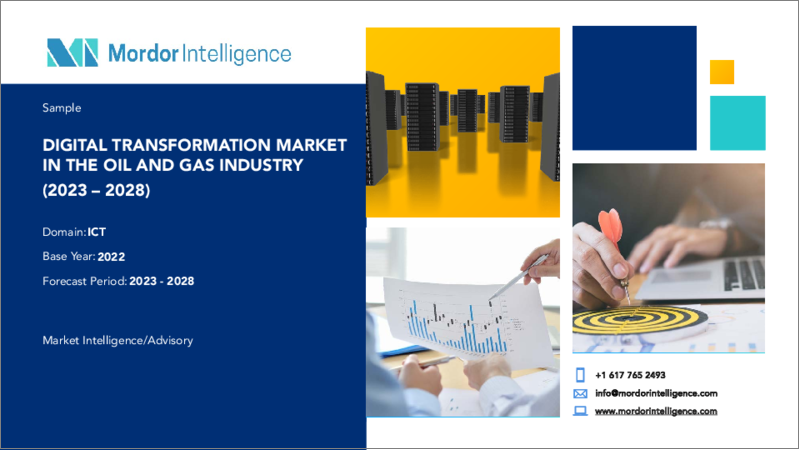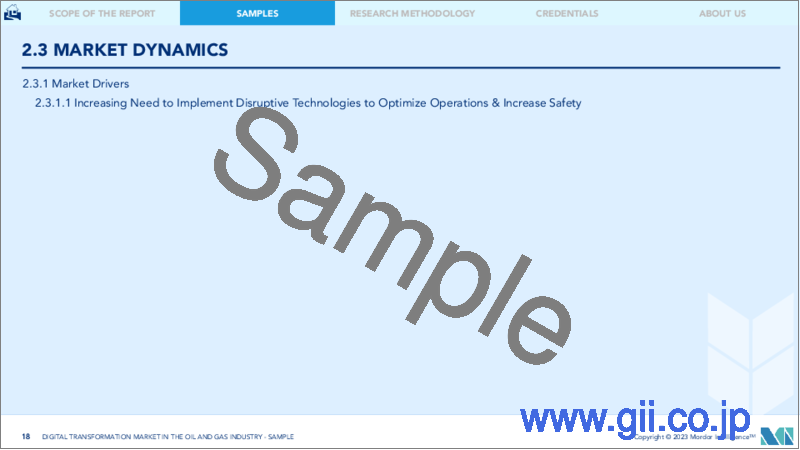|
|
市場調査レポート
商品コード
1190604
石油・ガス業界におけるデジタルトランスフォーメーション市場- 成長、動向、予測(2023年-2028年)Digital Transformation Market In The Oil and Gas Industry - Growth, Trends, and Forecasts (2023 - 2028) |
||||||
|
● お客様のご希望に応じて、既存データの加工や未掲載情報(例:国別セグメント)の追加などの対応が可能です。 詳細はお問い合わせください。 |
|||||||
価格
| 石油・ガス業界におけるデジタルトランスフォーメーション市場- 成長、動向、予測(2023年-2028年) |
|
出版日: 2023年01月18日
発行: Mordor Intelligence
ページ情報: 英文 120 Pages
納期: 2~3営業日
|
ご注意事項 :
本レポートは最新情報反映のため適宜更新し、内容構成変更を行う場合があります。ご検討の際はお問い合わせください。
- 全表示
- 概要
- 目次
概要
主なハイライト
- 石油・ガス業界におけるデジタルトランスフォーメーション市場は、予測期間中にCAGR9.5%を記録すると予想されます。デジタルトランスフォーメーションは、過去10年以来、世界の石油・ガス業界を牽引する重要な動向の1つとなっています。この変革は、AI、IoT、ビッグデータなどの高度なデジタル技術を活用した効率化を可能にし、それにより、デジタルツインを含む可能性があるため、明らかに重要資産の予知保全の効率を高め、それによって施設内の作業員が危険な作業にさらされることを抑制し、新しい機会を切り開くものです。
- 拡張現実は、石油・ガス産業における最新かつ新たなソリューションです。シェル、エクソンモービル、BPなどの企業は、この分野で没入型技術を採用した最初の企業の一つです。
- オフショア石油・ガス事業では、データサイエンスにAIを活用することで、石油・ガスの探査や生産に使われる複雑なデータをより到達しやすくし、企業が新しい探査の見通しを発見したり、既存のインフラをより活用できるようにします。例えば最近、BPはヒューストンに拠点を置く新興企業ベルモント・テクノロジーに投資し、同社のAI能力を強化するとともに、"Sandy"というニックネームのクラウドベースの地球科学プラットフォームを開発しました。
- すべての実現技術の中で、人工知能は予測期間中に重要な役割を果たすと考えられています。AIは、ガソリンスタンドの予防保全のための安全性を高めるためにも利用されています。しかし、ガソリンスタンドでの火災の発生が増加しています。例えば、ラスベガスのマッカラン空港のガソリンスタンドでは、2021年9月に火災事故が発生しました。このような事象は致命的となり、ガソリンスタンドやその周辺を破壊する可能性があります。しかし、AIに基づくインテリジェントカメラは、リスクエリアにアクセスし、潜在的な被害の程度を軽減することができます。
- 2021年11月、ElectrifAiはアブダビで開催されたADIPECにおいて、石油・ガス・エネルギー業界向けにComputer Vision(CV)とMachine Learning as a Service(MLaaS)を提供することを発表しました。ElectrifAiのMLaaSを利用すれば、企業はほとんど経験を必要とせず、AIとMLのビジネスおよび運用上のメリットを最大限に実現することができます。MLaaSは、あらゆるクラウド環境内やお客様宅に迅速に展開されます。
- また、IoTなどのモニター機器を採用することで、企業はプロセスの自動化・最適化を図り、機器を常時監視することで安全性や規制の問題、遠隔アクセスなどのリスクを排除し、業界のさらなるデジタル化を実現することができます。
- さらに、COVID-19の影響で2020年にかけて原油価格が大幅に下落し、サウジアラビアとロシアの価格競争が起きていることが、産油企業にとって自動化を導入する大きな抑制要因として作用しています。また、国際エネルギー機関(IEA)によると、テキサス州に本社を置くオクシデンタル・ペトロリウム社(Oxy)は、世界の石油・ガス生産企業の中で2020年の設備投資額を最も大幅に削減したとのことです。COVID-19により、オキシは2020年の設備投資を48.1%削減し、年初に計画した52億米ドルから27億米ドルに減額しました。しかし、このパンデミックによって、石油・ガス業界のデジタル化の必要性が大きくクローズアップされました。そのため、企業はこのような変革への投資を計画し始め、予測期間中に市場は成長すると予想されます。
主な市場動向
川下部門が大きな市場シェアを占める見込み
- デジタルトランスフォーメーションは、石油・ガス産業の下流事業をリードする中核的なイノベーションの1つと考えられています。各社は、プラントの製造効率を高めることで、資産の利用率を高めることに注力しています。
- 石油・ガス会社の下流事業(石油化学と精製の両方を含む)は、常に事業を改善するための技術を採用してきました。これらの企業は、複雑なプロセスを管理し、データを解釈してパフォーマンスを向上させる革新的なアプローチを開発し、採用してきました。石油・ガスバリューチェーンの下流事業、特に石油化学事業を拡大しようとする多くの企業の戦略的な推進により、デジタル化への移行が進行しているため、さらに大きな可能性が期待されます。
- ベンダーが関心を寄せる主要な分野は、メンテナンスコストをいかに予測し、防止・削減するかということです。メンテナンスとターンアラウンドプランニングツールの自動化ソリューションは、アプリケーションパフォーマンス管理とAIベースのシミュレーションを使用しており、既存のオペレーションシステムに簡単に追加することができます。さらに、より優れた予測的・予知的メンテナンスを可能にするセンサーシステムのアップグレードは、長期的な運用効率につながります。
- 複数の石油・ガス会社が、AI、IoT、ビッグデータなどの技術に頼って、運用を改善しています。例えば、石油・ガスを最終消費者に供給する役割を担うシェルのダウンストリーム商業事業では、AI技術を利用して、石油製品に対する消費者の需要を予測し、供給不足を測定し、精製プロセスの石油の配合を推奨しています。
- さらに、同分野の拡大も、予測期間中の市場成長率を押し上げる要因となっています。例えば、2022年5月、アジアにおける下流のプレゼンスを拡大する中で、サウジアラビア石油会社(以下、アラムコ)は、タイの政府系石油会社PTTとの協業を発表しました。両組織は、原油の調達、精製、石油化学製品、LNG(液化天然ガス)の販売におけるパートナーシップの向上を目指しています。また、ブルー水素やグリーン水素、多くのクリーンエネルギー・プログラムも提携の対象となる可能性があります。
- また、2020年の世界の原油需要は、日量9100万バレルに減少しました。2020年の減少は、コロナウイルスの大流行で世界的に操業停止が広がるなど、経済的・機動的な影響を受けたためです。エネルギー情報局(EIA)によると、2023年の原油生産量は日量1億120万バレルと予測されています。原油生産量の増加も、市場の成長をさらに後押しすると予想されます。
アジア太平洋地域が大きなシェアを占める
- この地域は石油・ガス産業において大きな市場シェアを占めています。また、IBEFによると、インドはOECD以外の石油消費量の成長に世界的に最も貢献する国のひとつになると予想されています。インドの石油製品消費量は、FY22で2,042万3,000トンでした。高速ディーゼルはインドで最も消費される石油製品であり、FY22の石油製品消費量の38.84%を占めました。
- さらに、2022年1月、Indian Oil Corp.Ltd(IOCL)は都市ガス配給(CGD)事業を拡大する計画を発表し、7,000クローナ(918.6百万米ドル)の投資を検討しています。
- 中国、インド、日本、韓国などの国々は、アジア太平洋地域で最も活発な石油・ガス下流部門の1つで、石油精製能力の78%以上を担っており、石油化学製品製造装置と深く統合された大規模な精製所を持っています。さらにIBEFによると、インドは原油価格の高騰を相殺するために、SPR(戦略石油備蓄)の50%を商業化して資金を調達し、追加の貯蔵タンクを建設することを目指しています。
- さらに、シンガポールのような国は、1年で10%以上の製油所処理能力を獲得しています。これは、現在の製油所の拡張の余地を提供し、場合によっては新規プロジェクトがデジタル・トランスフォーメーションの需要を促進することが期待されます。
- 石油・ガス生産に関わる長いリードタイムと膨大な資本支出を考えると、この業界の重要なプレーヤーは、AIなどの変革技術によって競争力を得ようとしています。例えば、オーストラリアの最も重要な天然ガス生産会社であるWoodsideは、IBM Watsonを導入してAIアルゴリズムの運用を行い、2500万以上の文書の検索、コンテンツの取得、過去のパフォーマンスとのベンチマーク、関連情報の提案を業務内の誰にでも行うことができるようにしました。
- さらに、アジアを代表するペトロチャイナは、20年後に5000万トンの安定生産を目指す大慶油田で、クラウドコンピューティング、ビッグデータ、IoTなどの技術を実現し、デジタル変革を活用すると発表しています。
- しかし、2021年には石油・ガス部門が大幅に回復し、COVID-19以前の水準に押し上げられます。国際エネルギー機関(IEA)は2021年10月の最新報告書で、世界の石油需要の拡大が7%であるのに対し、インドでは2030年までに50%増加すると予測しました。このため、同分野の成長が市場を牽引すると期待されています。
競合情勢について
世界の石油・ガス業界におけるデジタルトランスフォーメーション市場は、競争が激しく、複数の主要なプレーヤーで構成されています。
市場で顕著なシェアを持つプレイヤーは、海外に広がる顧客基盤の拡大に注力しています。これらの企業は、市場シェアと収益性を高めるために、戦略的な協力イニシアティブと買収を活用しています。
- 2021年10月- エマソンは、Aspen Technology, Inc.と、エマソンの単体の産業用ソフトウェア事業であるOpen Systems International, Inc.と地質シミュレーションソフトウェア事業の2つを統合し、AspenTech株主に現金60億米ドルを拠出し、より優れた能力、規模、技術を持つ多様で高性能な産業用ソフトウェア部門である「新AspenTech」を設立する最終契約を締結しました。
- 2021年5月-Shell Philippines Exploration社が運営するMalampaya天然ガス生産・処理施設の信頼性を高めるためにEmerson Electric社がオートメーション技術をアップグレードし、予定より早く作業を終えることで計画通りにガスの供給を回復させました。したがって、フィリピンは、よりきれいに燃える天然ガスを引き続き使用して経済を動かすことができるようになる、というメリットがあります。
その他の特典
- エクセル形式の市場予測(ME)シート
- 3ヶ月間のアナリスト・サポート
目次
第1章 イントロダクション
- 調査の前提条件と市場の定義
- 調査対象範囲
第2章 調査手法
第3章 エグゼクティブサマリー
第4章 マーケットインサイト
- 市場概要
- 産業の魅力- ポーターのファイブフォース分析
- 供給企業の交渉力
- 買い手の交渉力
- 新規参入業者の脅威
- 代替品の脅威
- 競争企業間の敵対関係
- 産業バリューチェーン分析
- COVID-19が市場に与える影響評価
第5章 市場力学
- 市場促進要因
- オペレーション最適化と安全性向上のための破壊的技術導入の必要性の高まり
- 規制要件
- 市場の課題
- 石油価格の変動
- 先進国における産業の成長鈍化
第6章 市場セグメンテーション
- 実現技術別
- ビッグデータ/アナリティクスとクラウドコンピューティング
- モノのインターネット(IoT)
- 人工知能(Artificial Intelligence
- 産業用制御システム(PLC、SCADA、HMI、DCSなど)
- 拡張現実感(AR、VR、MR)
- フィールドデバイス(センサー、モーター、VFDなど)
- 石油・ガス産業活動別
- 上流部門
- 中流部門
- 下流部門
- 地域別一覧
- 北米
- 米国
- カナダ
- 欧州
- ドイツ
- 英国
- フランス
- その他の欧州地域
- アジア太平洋地域
- 中国
- 日本
- インド
- その他アジア太平洋地域
- ラテンアメリカ
- ブラジル
- アルゼンチン
- その他のラテンアメリカ地域
- 中東・アフリカ地域
- アラブ首長国連邦
- サウジアラビア
- その他の中東・アフリカ地域
- 北米
第7章 競合情勢
- 企業プロファイル
- Schneider Electric SE
- Rockwell Automation Inc.
- Honeywell International Inc.
- Siemens AG
- IBM Corporation
- Mitsubishi Electric Corporation
- Omron Corporation
- Yokogawa Electric Corporation
- Fanuc Corporation
- Emerson Electric Co.
- WFS Technologies Ltd
- Magseis Fairfield ASA
- Rohrback Cosasco Systems Inc.
- ABB Ltd
第8章 投資分析
第9章 市場の将来性
目次
Product Code: 69175
Key Highlights
- The digital transformation market in the oil and gas industry is expected to register a CAGR of 9.5% during the forecast period. Digital transformation has been one of the key trends driving the global oil and gas industry since the last decade. This transformation enables the operations to leverage advanced digital technologies such as AI, IoT, and Big Data, among others, to drive efficiencies and thereby open up new opportunities for the same, as it might involve digital twins, which evidently improves the efficiency of predictive maintenance of the critical assets and thereby restricting the exposure of hazardous task to the workers in the facilities.
- Extended reality is the latest and emerging solution in the oil and gas industry. Companies such as Shell, ExxonMobil, and BP are among the first players to adopt immersive technologies in the field.
- The offshore oil and gas business uses AI in data science to make the complex data used for oil and gas exploration and production more reachable, which lets companies discover new exploration prospects or make more use of existing infrastructures. For instance, recently, BP invested in Houston-based start-up Belmont Technology to strengthen the company's AI capabilities and develop a cloud-based geoscience platform nicknamed "Sandy."
- Among all the enabling technologies, artificial intelligence is poised to play a significant role over the forecast period. AI is also used to increase the safety of gas stations for preventive maintenance. However, there have been growing incidences of fires at gas stations. For instance, a gas station in Mccarran Airport in Las Vegas had an accidental fire in September 2021. Such events may prove deadly and destroy gas stations and the surrounding area. However, intelligent cameras based on AI can access the risk area and lessen the extent of potential damage.
- In November 2021, ElectrifAi announced the availability of Computer Vision (CV) and Machine Learning as a Service (MLaaS) for the oil, gas, and energy industries at ADIPEC in Abu Dhabi. With ElectrifAi's MLaaS, companies need little to no experience to realize the maximum business and operational benefits of AI and ML. MLaaS deploys quickly within any cloud environment or on the customer premise.
- Additionally, adopting monitor equipment such as IoT will allow companies to further digitize the industry by automating and optimizing the processes and eliminating the risk associated, including safety and regulation issues, and remote access, by constantly monitoring the equipment.
- Furthermore, the oil prices declining drastically over 2020, in the wake of COVID-19, and a price war between Saudi Arabia and Russia, are acting as major restraints for oil-producing companies to deploy automation. In addition, according to the International Energy Agency (IEA), Texas-based Occidental Petroleum Corporation (Oxy) has made the most significant reduction in its capital expenditures for 2020 out of all global oil and gas producers in the world. COVID-19 has caused Oxy to reduce its 2020 capex by 48.1%, down to USD 2.7 billion from the USD 5.2 billion planned at the beginning of the year. However, the pandemic significantly highlighted the need for digitalization in the oil and gas industry. As such, companies started to plan investments in such transformations; hence, the market is expected to grow over the forecast period.
Key Market Trends
Downstream Sector is Expected to Witness Major Market Share
- Digital transformation is considered one of the core innovations in leading the downstream operations of the oil and gas industry. The companies are focusing on increasing asset utilization by enhancing the manufacturing efficiency of the plants.
- The downstream operations of the oil and gas companies, including both petrochemicals and refining, have always adopted technology to improve their operations. These companies have developed and adopted innovative approaches that manage complex processes and interpret data to improve performance. The ongoing shift to becoming digital is expected to present even greater potential, given the strategic push by many companies to expand their downstream operations of the oil and gas value chain, especially petrochemicals.
- The primary area of concern for the vendors is how to predict and prevent or reduce maintenance costs. The automation solutions for maintenance and turnaround planning tools use application performance management and AI-based simulation and can be easily added to an existing operational system. Moreover, the upgradation of sensor systems to enable better predictive and prescriptive maintenance can lead to long-term operational efficiencies.
- Multiple oil and gas companies are relying on technologies such as AI, IoT, and Big Data, among others, to improve their operations. For instance, Shell's downstream commercial business, responsible for supplying oil and gas to the end consumer, uses AI technology to predict consumer demand for petroleum products, measure supply shortages, and recommend a mix of oil for a refining process.
- Furthermore, the growing expansions in the sector are also set to boost the market growth rate during the forecast period. For instance, in May 2022, as it extended its downstream presence in Asia, the Saudi Arabian Oil Company ("Aramco") announced a collaboration with Thailand's government oil company PTT. The organizations aim to improve their partnership in procuring crude oil, marketing refining, petrochemical products, and liquefied natural gas (LNG). Blue and green hydrogen, and numerous clean energy programs, are other possible areas of engagement.
- In addition, global demand for crude oil in 2020 decreased to 91 million barrels per day. The decrease in 2020 was due to the economic and mobility impacts of the coronavirus pandemic, including widespread shutdowns worldwide. According to the Energy Information Administration (EIA), Crude oil production is forecasted at 101.2 million barrels per day in 2023. The growing crude oil production is also expected to drive market growth further.
Asia-Pacific to account for a significant share
- The region holds a significant market share in the oil and gas industry. In addition, according to IBEF, India is expected to be one of the most important contributors to non-OECD petroleum consumption growth globally. India's consumption of petrol products stood at 204.23 MMT in FY22. High-Speed Diesel was India's most consumed oil product and accounted for 38.84% of petroleum product consumption in FY22.
- Furthermore, in January 2022, Indian Oil Corp. Ltd (IOCL) announced plans to expand its city gas distribution (CGD) business, looking to invest INR 7,000 crores (USD 918.6 million).
- Countries such as China, India, Japan, and South Korea have one of the most active oil and downstream gas sector in the region, which together is responsible for over 78% of the oil refining capacity, with significant refineries deeply integrated with petrochemical production units, in the Asian-Pacific region. Furthermore, according to IBEF, India aims to commercialize 50% of its SPR (strategic petroleum reserves) to raise funds and build additional storage tanks to offset high oil prices.
- Additionally, countries like Singapore are gaining over 10% refinery throughput in a year. This provides the scope for expansion in current refineries, and possibly new projects are expected to drive the demand for digital transformation.
- Given the long lead times and the massive capital outlay involved in oil and gas production, significant players in the industry are looking to gain a competitive edge through transformational technology such as AI. For instance, Woodside, the most significant Australian natural gas producer, deployed IBM Watson to run AI algorithms operations and search over 25 million documents, retrieve content, benchmark against historical performance, and suggest related information to anyone in the business.
- Furthermore, PetroChina, Asia's leading, announced that its Daqing oilfield, which is aimed to achieve 50 million tons of stable production in 20 years, will leverage digital transformation by enabling technologies such as cloud computing, big data, and IoT, among others.
- However, the oil and gas sector significantly recovered in 2021, boosting the industry to the pre-COVID-19 level. In India, the oil demand is expected to rise 50% by 2030 as against a global expansion of 7%, the International Energy Agency (IEA) has forecast in its latest report in October 2021. Thus, the growth in the sector is expected to drive the market studied.
Competitive Landscape
The global digital transformation market in the oil and gas industry is highly competitive and consists of several major players. The players with a prominent share in the market are focusing on expanding their customer base across foreign countries. These companies leverage strategic collaborative initiatives and acquisitions to increase their market share and profitability.
- October 2021 - Emerson entered into a definitive agreement with Aspen Technology, Inc. to combine two of Emerson's stand-alone industrial software businesses, Open Systems International, Inc. and the geological simulation software business, along with a contribution of USD 6 billion in cash to AspenTech shareholders, to create "new AspenTech," which is a diversified, high-performance industrial software segment with more excellent capabilities, scale, and technologies.
- May 2021 - Emerson Electric Co. upgraded automation technology to improve the reliability of the Malampaya natural gas production and processing facilities operated by Shell Philippines Exploration, and finishing the work ahead of schedule helped the company restore the supply of gas as planned; therefore, the Philippines would benefit from the continued use of cleaner-burning natural gas to power its economy.
Additional Benefits:
- The market estimate (ME) sheet in Excel format
- 3 months of analyst support
TABLE OF CONTENTS
1 INTRODUCTION
- 1.1 Study Assumptions and Market Definition
- 1.2 Scope of the Study
2 RESEARCH METHODOLOGY
3 EXECUTIVE SUMMARY
4 MARKET INSIGHTS
- 4.1 Market Overview
- 4.2 Industry Attractiveness - Porter's Five Forces Analysis
- 4.2.1 Bargaining Power of Suppliers
- 4.2.2 Bargaining Power of Buyers
- 4.2.3 Threat of New Entrants
- 4.2.4 Threat of Substitutes
- 4.2.5 Intensity of Competitive Rivalry
- 4.3 Industry Value Chain Analysis
- 4.4 Assessment of Impact of COVID-19 on the Market
5 MARKET DYNAMICS
- 5.1 Market Drivers
- 5.1.1 Increasing Need to Implement Disruptive Technologies to Optimize Operations & Increase Safety
- 5.1.2 Regulatory Requirements
- 5.2 Market Challenges
- 5.2.1 Volatile Oil Price Situation
- 5.2.2 Stagnant Industrial Growth in Developed Countries
6 MARKET SEGMENTATION
- 6.1 By Enabling Technologies
- 6.1.1 Big Data/Analytics and Cloud Computing
- 6.1.2 Internet of Things (IoT)
- 6.1.3 Artificial Intelligence
- 6.1.4 Industrial Control Systems (PLC, SCADA, HMI, DCS etc.)
- 6.1.5 Extended Reality (AR, VR and MR)
- 6.1.6 Field Devices (Sensors, Motors, VFD etc.)
- 6.2 By Oil and Gas Industry Activity
- 6.2.1 Upstream
- 6.2.2 Mid Stream
- 6.2.3 Downstream
- 6.3 By Geography
- 6.3.1 North America
- 6.3.1.1 United States
- 6.3.1.2 Canada
- 6.3.2 Europe
- 6.3.2.1 Germany
- 6.3.2.2 United Kingdom
- 6.3.2.3 France
- 6.3.2.4 Rest of Europe
- 6.3.3 Asia-Pacific
- 6.3.3.1 China
- 6.3.3.2 Japan
- 6.3.3.3 India
- 6.3.3.4 Rest of the Asia-Pacific
- 6.3.4 Latin America
- 6.3.4.1 Brazil
- 6.3.4.2 Argentina
- 6.3.4.3 Rest of Latin America
- 6.3.5 Middle East and Africa
- 6.3.5.1 United Arab Emirates
- 6.3.5.2 Saudi Arabia
- 6.3.5.3 Rest of Middle East and Africa
- 6.3.1 North America
7 COMPETITIVE LANDSCAPE
- 7.1 Company Profiles
- 7.1.1 Schneider Electric SE
- 7.1.2 Rockwell Automation Inc.
- 7.1.3 Honeywell International Inc.
- 7.1.4 Siemens AG
- 7.1.5 IBM Corporation
- 7.1.6 Mitsubishi Electric Corporation
- 7.1.7 Omron Corporation
- 7.1.8 Yokogawa Electric Corporation
- 7.1.9 Fanuc Corporation
- 7.1.10 Emerson Electric Co.
- 7.1.11 WFS Technologies Ltd
- 7.1.12 Magseis Fairfield ASA
- 7.1.13 Rohrback Cosasco Systems Inc.
- 7.1.14 ABB Ltd
8 INVESTMENT ANALYSIS
9 FUTURE OF THE MARKET
お電話でのお問い合わせ
044-952-0102
( 土日・祝日を除く )




